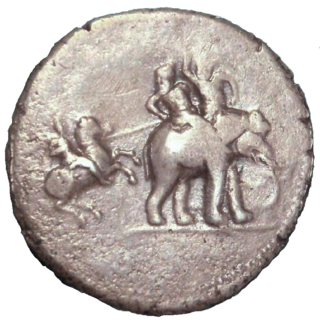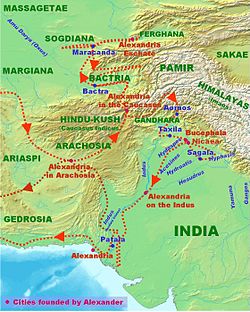
The ancient history of Afghanistan, also referred to as the pre-Islamic period of Afghanistan, dates back to the prehistoric era and the Helmand civilization around 3300–2350 BCE. Archaeological exploration began in Afghanistan in earnest after World War II and proceeded until the late 1970s during the Soviet–Afghan War. Archaeologists and historians suggest that humans were living in Afghanistan at least 50,000 years ago, and that farming communities of the region were among the earliest in the world. Urbanized culture has existed in the land from between 3000 and 2000 BC. Artifacts typical of the Paleolithic, Mesolithic, Neolithic, Bronze, and Iron ages have been found inside Afghanistan.

The Seleucid Empire was a Greek power in West Asia during the Hellenistic period. It was founded in 312 BC by the Macedonian general Seleucus I Nicator, following the division of the Macedonian Empire founded by Alexander the Great, and ruled by the Seleucid dynasty until its annexation by the Roman Republic under Pompey in 63 BC.

This article concerns the period 329 BC – 320 BC.

Porus or Poros was an ancient Indian king whose territory spanned the region between the Jhelum River (Hydaspes) and Chenab River (Acesines), in the Punjab region of the Indian subcontinent. He is only mentioned in Greek sources. Credited to have been a legendary warrior with exceptional skills, Porus unsuccessfully fought against Alexander the Great in the Battle of the Hydaspes. In the aftermath, an impressed Alexander not only reinstated him as his satrap but also granted him dominion over lands to the south-east extending as far as the Hyphasis (Beas). Porus reportedly died sometime between 321 and 315 BC.

Seleucus I Nicator was a Macedonian Greek general, officer and successor of Alexander the Great who went on to found the eponymous Seleucid Empire, led by the Seleucid dynasty. Initially a secondary player in the power struggles following Alexander's death, Seleucus rose to become the total ruler of Asia Minor, Syria, Mesopotamia, and the Iranian plateau, assuming the title of basileus (emperor). The Seleucid Empire was one of the major powers of the Hellenistic world, until it was overcome by the Roman Republic and Parthian Empire in the late second and early first centuries BC.

Demetrius I Anicetus, also called Damaytra was a Greco-Bactrian and later Indo-Greek king, who ruled areas from Bactria to ancient northwestern India. He was the son of the Greco-Bactrian Kingdom's ruler Euthydemus I and succeeded him around 200 BC, after which he conquered extensive areas in what is now southern Afghanistan, Iran and Pakistan and India.

Chandragupta Maurya was the founder of the Maurya Empire, a geographically-extensive empire based in Magadha. He reigned from 320 BCE to 298 BCE. The Magadha kingdom expanded to become an empire that reached its peak under the reign of his grandson, Ashoka the Great, from 268 BCE to 231 BCE. The nature of the political formation that existed in Chandragupta's time is not certain. The Mauryan empire was a loose-knit one with large autonomous regions within its limits.
Megasthenes was an ancient Greek historian, diplomat, ethnographer and explorer in the Hellenistic period. He described India in his book Indica, which is now lost, but has been partially reconstructed from literary fragments found in later authors that quoted his work. Megasthenes was the first person from the Western world to leave a written description of India.

Greco-Buddhism or Graeco-Buddhism denotes a supposed cultural syncretism between Hellenistic culture and Buddhism developed between the 4th century BC and the 5th century AD in Gandhara, in present-day Pakistan and parts of north-east Afghanistan. While the Greco-Buddhist art shows clear Hellenistic influences, the majority of scholars do not assume a noticeable Greek influence on Gandharan Buddhism beyond the artistic realm.

The Maurya Empire was a geographically extensive Iron Age historical power in South Asia based in Magadha. Founded by Chandragupta Maurya in 322 BCE, it existed in loose-knit fashion until 185 BCE. The empire was centralized by the conquest of the Indo-Gangetic Plain; its capital city was located at Pataliputra. Outside this imperial centre, the empire's geographical extent was dependent on the loyalty of military commanders who controlled the armed cities scattered within it. During Ashoka's rule the empire briefly controlled the major urban hubs and arteries of the Indian subcontinent excepting the deep south. It declined for about 50 years after Ashoka's rule, and dissolved in 185 BCE with the assassination of Brihadratha by Pushyamitra Shunga and foundation of the Shunga dynasty in Magadha.

The Battle of the Hydaspes also known as Battle of Jhelum, or First Battle of Jhelum, was fought between Alexander the Great and Porus in May of 326 BC. It took place on the banks of the Hydaspes River in Punjab, as part of Alexander's Indian campaign. In what was possibly their most costly engagement, the Macedonian army secured a decisive victory over the Pauravas and captured Porus. Large areas of Punjab were subsequently absorbed into the Macedonian Empire; Porus was reinstated as the region's ruler after Alexander, having developed a newfound respect for the fierce resistance put up by Porus and his army, appointed him as a satrap.

The Indo-Greek Kingdom, or Graeco-Indian Kingdom, also known historically as the Yavana Kingdom (Yavanarajya), was a Hellenistic-era Greek kingdom covering various parts of modern-day Afghanistan, Pakistan and northwestern India. This kingdom was in existence from c. 200 BC to c. 10 AD.

The Nanda dynasty was the fifth ruling dynasty of Magadha in northern Indian subcontinent during the fourth century BCE and possibly also during the fifth century BCE. The Nandas overthrew the Shaishunaga dynasty, and expanded the empire to include a larger part of northern India. Ancient sources differ considerably regarding the names of the Nanda kings and the duration of their rule, but based on the Buddhist tradition recorded in the Mahāvaṃsa, they appear to have ruled during c. 345–322 BCE, although some theories date the start of their rule to fifth century BCE.

The Pauravas were an ancient tribe in the Indus valley, to which King Porus may have belonged.

Dhana Nanda, according to the Buddhist text Mahabodhivamsa, was the last ruler of the Nanda dynasty of ancient India. He was the youngest son of Mahapadma Nanda.

The Indian campaign of Alexander the Great began in 327 BC and lasted until 325 BC. After conquering the Achaemenid Persian Empire, the Macedonian army undertook an expedition into the northwestern Indian subcontinent. Within two years, Alexander expanded the Macedonian Empire to include present-day Punjab and Sindh in what is modern-day Pakistan, surpassing the earlier frontiers that had been established by the Persian conquest of the Indus Valley.

Chandragupta is a board wargame designed by Stephen R. Welch and released in 2008 by GMT Games as part of the Great Battles of History (GBoH) series of games on ancient warfare. Chandragupta simulates battles fought by the Mauryan Dynasty in ancient India, and in so doing, attempts to illuminate the features, challenges, and unique attributes of the Indian military system and culture during this period.

The Seleucid–Mauryan War was fought between 305 and 303 BC. It started when Seleucus I Nicator of the Seleucid Empire sought to retake the Indian satrapies of the Macedonian Empire, which had been occupied and administered by Emperor Chandragupta Maurya, of the Mauryan Empire.

Chandragupta Maurya is an Indian Historical drama series being broadcast on Dangal TV, based on the life of Chandragupta Maurya, an Indian emperor of ancient India and the founder of the Mauryan Empire. Chandragupta Maurya was first aired in March 2011 on Imagine TV. Ashish Sharma played the adult and Rushiraj Pawar played the young Chandragupta Maurya.

Chandragupta Maurya is an Indian historical television show that aired on Sony TV from 14 November 2018 to 30 August 2019. Written by Raj Routh, the show is based on the life of Chandragupta Maurya, the first Mauryan emperor and founder of the Maurya Empire. The show is produced by Siddharth Kumar Tewary's One Life Studios.

























